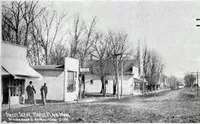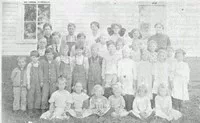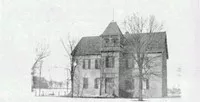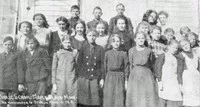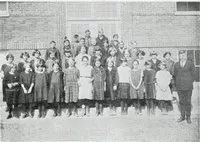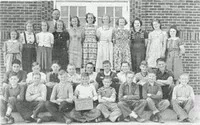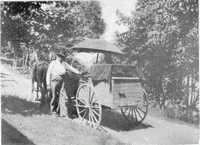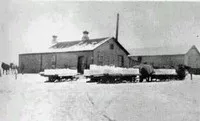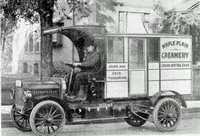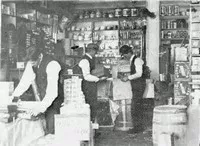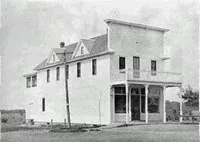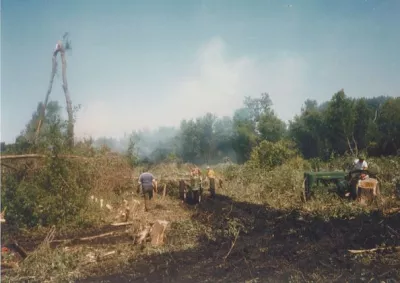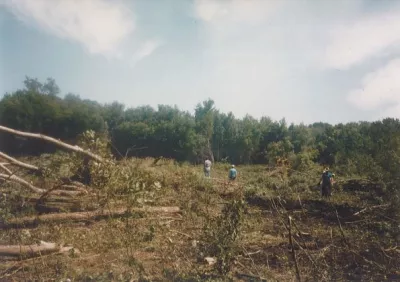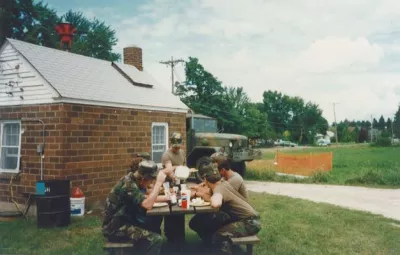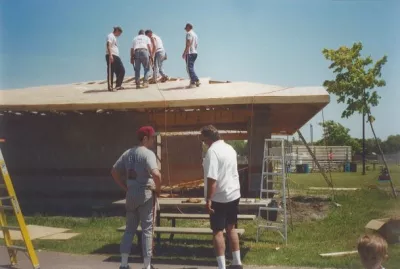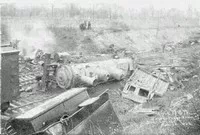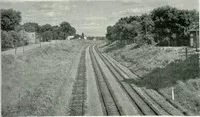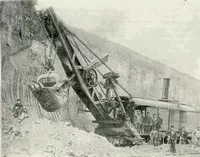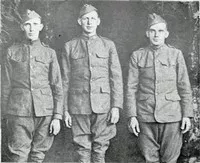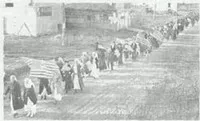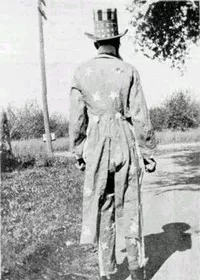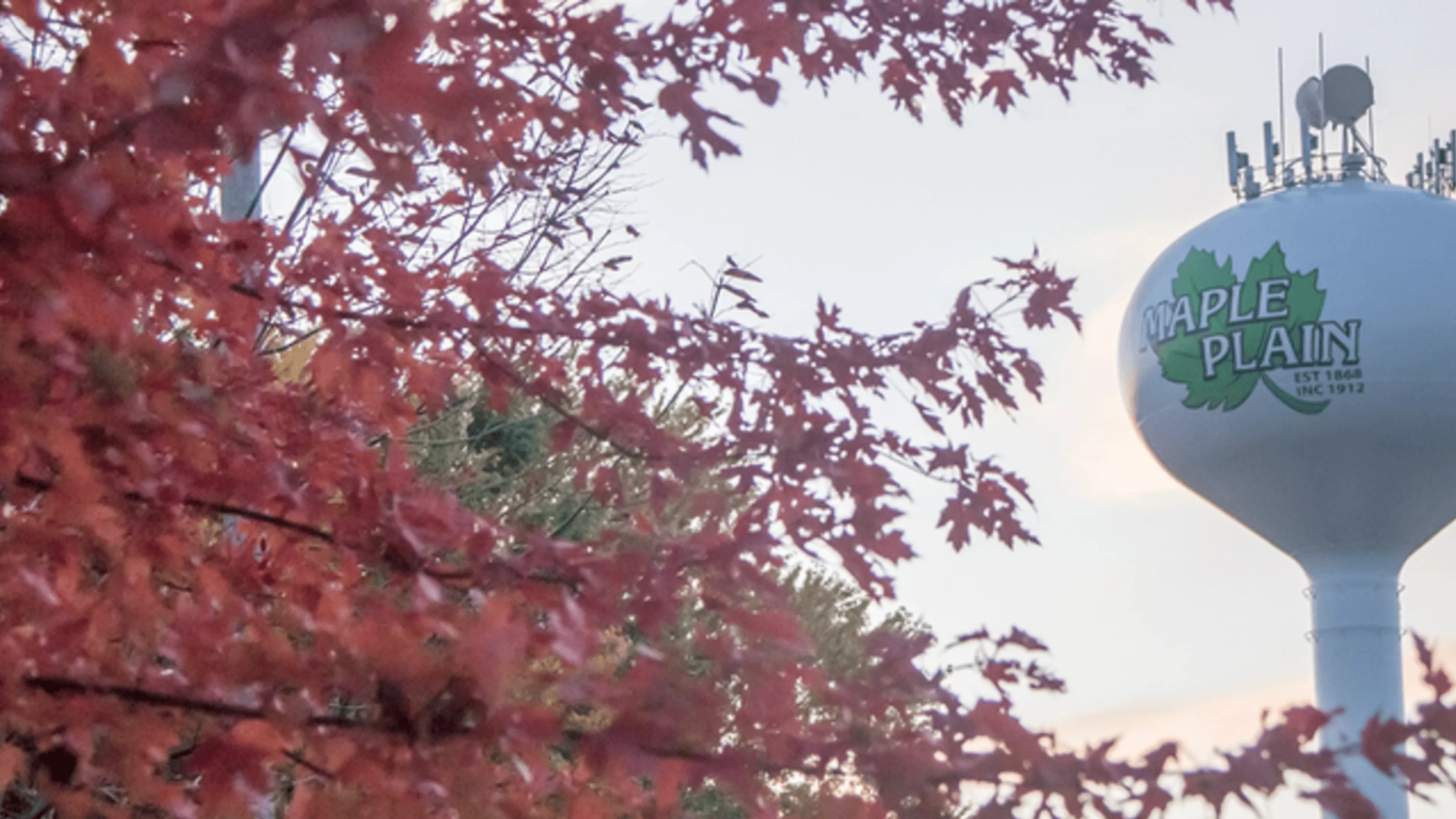
History
In 1968 (100 years after the village plat was laid out), the Maple Plain Garden Club published the book "Maple Plain & Independence: Past-Present, 1868-1968" that provides many details and accounts of Maple Plain's early history.
"Well now, it's root, hog or die!" These were John Jacob Batdorf's words of advice to his daughter, Margaret, and young William Mills when he was told they had been married a few hours after they reached Fort Snelling on May 8, 1857. William had hired out to one of the pioneers on the wagon train just to be near "Maggie". That they "rooted" is evidenced by the flourishing family tree that remains in this area.
John Jacob Batdorf, usually known as Jacob, and his family left New Castle, Indiana, with a group of pioneers in April 1857 headed for Minnesota. They traveled by covered wagon to the Ohio River where they loaded their possessions on flatboats. They traveled down the Ohio to the Mississippi and from there up river to Fort Snelling. Most of the group went west from Fort Snelling and settled in what is now Independence. After being enroute for a month, supplies ran very low. The story is told that the family lived almost entirely on dandelion greens for three weeks.
Jacob's family were his wife, Lydia, sons John, William, Jacob and Barton and daughters Margaret and Maria. John married Margaret Bradford, William married Jane Styner and Barton married Jeanette Alger. Margaret married William Mills and Maria married his younger brother, Robert M. Mills. Jacob Jr. was killed before the Civil War when he was hit by a falling tree.
In 1862 the settlers were alarmed by rumors of an impending Indian uprising. The men of Rockford thought it wise to build a stockade. They hurriedly used whatever materials were available, part of which happened to be the planks which had recently been sawed at the mill for John Batdorf's barn. Holes were cut in the planks for the men's rifles. The Indians did not attack. After about two months the stockade was torn down, and John built his barn. The rifle holes were reminders of early days as long as the barn stood.
When the call was given for volunteers for the Civil War, Jacob enlisted with his sons John and William and his son-in-law, William Mills. With most of the able bodied men off to war the women were sometimes called upon to perform rather unlady like tasks. The meat supply ran out. Margaret Batdorf Mills and Mrs. Styner bravely took it upon themselves to butcher a hog for their families.
After the war the men, except William Batdorf, who died of fever, returned to their farms and to the rearing of their families. John's children were William, Sarah, Albert, Eva, Melvin, John, Niles and Allen. Eva married Grant Beal. William's children were Dora, Norman, Stella, Bertha, Joseph, Roy and Henry.
The women occasionally visited in the afternoon. Margaret Batdorf chided her neighbor, Mrs. Williams, for not having visited her for so long. Mrs. Williams said, " I have so much work to do, I just can't get away." Margaret said, "Bring your work along."
One day Margaret called her daughter, Eva, to the window and asked, "What in time is that coming down the road?"
They couldn't decide what the big white thing was bobbing along the road. When it came very near, they discovered "the thing" was Mrs. Williams carrying her freshly filled straw tick. She would sew up the end of it as she visited. For Mrs. Williams, whose sense of humor was as big as her straw tick, the two-mile walk for ten minutes work was worth it for the merriment she created.
Three generations of Batdorfs attended the Evergreen Grove school in Independence on County Road 11. They were Niles and his daughters, Mildred (Mrs. Earnest Walker), Leona (Mrs. Eldon Anderson), Verna (Mrs. Philip Hamilton), his son B. Niles Batdorf M.D. and his grandchildren, the Andersons, Virginia (Mrs. Frank Ferrin), and Marie (Mrs. Albin J. Jacobson). Willis and Marilyn (Mrs. Robert Hamilton) Beal also attended Evergreen Grove school.
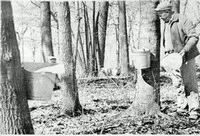
John Beer came to Independence township from Jordan, Minnesota, in 1880. He built his home where the old Hedin house now stands. He used a stone boat and a team of oxen to clear the land. He made a shoulder yoke and hauled water from a spring in the creek. During dry spells he would carry water from the lake. They lived on the farm for 14 years. Five children were born, John, Priscilla, Hilton, Harry, and Jesse. Lorna was born after they moved into Maple Plain.
In 1894, the Beer family moved into Maple Plain where John Beer had a hardware store and lumber yard.
Hilton Beer was 17 when the cut was put through Maple Plain for the railroad. He worked on the steam shovel and traveled around the country with it. Later he worked for Preston McCulley in the ginseng and became interested in growing it. In 1931 his home on Lake Independence was built. He also built five cottages and at one time had 25 boats to rent out for fishing and pleasure. Here he worked in his ginseng, maple syrup, and strawberries until he passed away on Nov. 23, 1962. His son Merle and family live in the same house he built. Merle's grandfather, John, built a home at Jordan that still stands near the highway going to Shakopee. Jessie James stopped at their place to water his horses on his way to rob the bank at Northfield, Minnesota.
The Bergman Silo Co. was founded in 1915 in Princeton, Minn. by the father of the two present owners. L. E. Bergman operated out of Princeton from 1915-1933. In the spring of 1934 the business was moved to St. Louis Park, Minn., where it was located for 26 years. With the growth of this suburb it was necessary to relocate and in the fall of 1959 the three acres on the west edge of Maple Plain, which constitute its present site, were purchased.
Sales volume has shown a steady increase and the company presently builds about 125 silos annually over a five state area. The size of each silo varies and many are as wide as 24 ft. and as high as 80 ft.
The father and founder died in 1957. Since then, his two sons, Virgil and Clinton have acted as President and Vice President respectively.
The Boy Scouts of America were active in Maple Plain as early as 1919 when Mr. Murry Hill was Scoutmaster. At that time their activities were mainly hiking, cooking out, camping in the woods, tree identification and fun on the farm. No one had uniforms. Today, the Scouts participate in those same basic activities plus long term camping at Many Point Scout Reservation, Viking Council Scout-0-Rama, Jamborees, and District Camporees. The Troop has supplied it's own camping gear, 2 canoes, a bus, and money to enable the boys to pay their camping fees through waste paper collections and Christmas tree sales. They have been chartered under the number 314 (Troop and Cub Pack) since 1953 with the First Presbyterian and Christ Lutheran churches as sponsoring organizations. Irvin Ganz has been Scoutmaster since 1960, Wences Horak is the present Cubmaster.
George Bradford came with others from Indiana to Independence at the close of the Civil War, travelling together by covered wagons. Their land, preempted in Section 34, later known as the Kowalke farm, lay next to Gustav Johnson's on the west. They were near neighbors of the Stinsons. There were seven children, three boys and four girls, all living at home at the time their home burned to the ground. The family of nine were made welcome at the John Stinson and Gustave Johnson homes until a new building could be made ready with the help of neighbors. Mr. Bradford died October 29, 1895. He and his wife Ellen are buried in Lewis Cemetery. Kate, the last known member of the family died in Great Falls, Montana in 1957. Percy Bradford, only son of John Bradford, lived most of his life in this community and passed away while visiting in Florida.
Four brothers, Henry Clay, William White, Daniel Clark and Joseph Charles Budd came to Maple Plain in 1865 from Indiana. Joseph some years later went back to Indiana. This family and Dave Cox, the Franklins, Fogelmans, Bradfords, and others came together at the close of the Civil War, travelling with their families by covered wagon and suffering many hardships. All of these men were veterans of the ninth Indiana Battery.
Henry Clay Budd and his wife Eliza Ann, two daughters Mattie and Alice and son Oliver arrived in Maple Plain having traveled by ox team with other settlers from Indiana. They settled on Section 25 where they built a log cabin. Another son, William Marshall and daughters Grace and Nellie were born here. Later they built a large house on what is now Budd Street. It was the first frame house in Maple Plain. Henry Clay and Eliza lived in this house until they passed away.
Mattie married Joseph Chapman and had Grace and Eldon.
William Marshall married Zua Obert and passed away here in 1921. Their children were Howard, Gladys Setzler, Claude, Meryl and Lois Welker. The Claude Budd's have two sons, William and Robert, and the children of Meryl are James, Gerald, Kelly, John, Patricia and Rosemary.
Grace married Warren DeCamp and had daughters, Eestella and Etta.
Nellie, married Joseph Drysdale. They had a son, Marvin.
William White. Budd came from Indiana with his wife, Emmeline, and daughters, Ella, Anna and Lilly and son, William in a prairie schooner. Later a son, Charles was born. They cleared and farmed the land where Halgren's Creamery stands. The old Odd Fellows Hall and many homes were later built on the site and also the Bryant farm. Later, with the advent of the first railroad through Maple Plain, the cut for the railroad was made through part of the Budd farm.
Ella Budd married William Perkins, son of B. Perkins of Perkinsville. He drove a team of oxen, called Tom and Jerry, that pulled a bob sled loaded with railroad ties.
Charles married Lilly May Kennedy, daughter of William H. H. and Mary Painter Kennedy. Charles was deputy sheriff of Hennepin County for many years. Their children were Aimee Florence, Clinton Charles, Mary Louella and Ethel Irene. Ethel married William Frederick Schultz and had children, Harry, Deloris Cole, Richard and Robert. Ethel later married Frederick Heohage.
The Civil War was in progress. From thirty to forty of the settlers served in the war. Some did not return. Among them was William Batdorf who died in the south of fever. Many were disabled. At one time, only three able-bodied men remained in the community. John McGary served during the Civil War along with S. Churchill, A. K. Richards, George Walsey, Robert Stimpson, James Shaver and others.
When the call was given for volunteers for the Civil War, Jacob Batdorf enlisted with his sons John and William and his son-in-law, William Mills.
In 1865, the following settlers came: Charles Ingerson, Fletcher Ingerson, Ashabel Ingerson, John and Calvin Wasson. R. M. Mills settled on the Moffitt farm. He was the father of Mrs. Mae Berquist, who has lived in Maple Plain most of her life. He was town clerk for 23 years and postmaster for 20 years. William Budd and Henry Clay Budd settled on Section 25. It is recorded that the two Budd brothers laid out the town of Maple Plain after the railroad came through in 1868.
G. W. Smith, who bought out the J. C. Perkins store, arrived in 1870. In 1876 Ben Drake bought out the store of George W. Mason. Asa Sonnett operated a steam saw mill. David Briley was the town blacksmith and H. C. Dickey was the wagon maker. Enock Cleaveland and Julius Hardt ran hotels. Good Templers Lodge was established in 1874. Harriet Smith, widow of G. W. Smith, ran the store which was later sold to E. A. Conover in about 1888. He operated the store until his death in 1931. Mrs. Conover, with the help of her son, Bonnie L. Conover, continued the store. She passed away in 1937 and the Conover twins, Eugene and Bonnie, ran the store until it was closed in 1954. Eugene was the husband of the former Louise Styner, an early teacher in Maple Plain. He served as Maple Plain village clerk for seventeen years and the village council meetings were held in the store. Before the railroad tracks were lowered because of the grade, the depot was across from Conover's store. The first Northwestern Bell telephone was installed in their store in a wooden booth in 1897 and people from the area came there to use the telephone.
David Cox came to Maple Plain in the 1860's. He was married to Lucinda Fogleman. He farmed south of Maple Plain, a strip stretching from what is now County Road 19, west to County Road 83, south of the old Rufus Bryant farm to what is now owned by Leslie Glomboski. At first, it was all timber and produced lots of maple sugar and syrup. They had two children, Charles and Nellie. Charles was born in Maple Plain, Dec. 9, 1866. He had a hotel and livery business which he opened in 1903 and operated for twenty-five years. The hotel was located on County Road 19 near the R.R. crossing. The livery barn was later used as a feed mill by Levi Carlson for many years. Then it was moved to Levi's place on the west side of Maple Plain where he continued to grind grain and sell feed until 1956 when the building was torn down.
Charles Cox passed away in 1958, and his wife, Frances, in 1943. Mr. Cox was 91 years of age, and survived by two sons, William of Wayzata and Melvin of Farmington, and one daughter, Mrs. Esther Stinson of Maple Plain. He had lived his whole life in this area.
Daniel S. Styner was born in Pennsylvania in 1815. He married Margaret Rheene in 1843. In 1856 he came to what is now Independence township and preempted 160 acres of land on Section 26. He was one of the pioneers of this town and was a member of the first town board, and later held many offices of trust. The house he built here in 1856 was the first to have a shingle roof. The Indians who passed near his home gave him the title of the "Dutch Squire". Three children came to Minnesota with their parents. They were Mary L., Julia E. and Charles. Cora was born while Minnesota was still a territory and Frank after it became a state. Lizzie, who was born in 1856, was the first girl to be born in Independence. The family settled on what is now land owned by the Herums, west of Maple Plain.
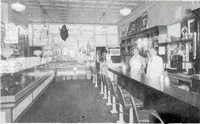
In the spring of 1932, W. R. Schultz purchased the confectionery store from Alfred Hillstrom. It became a store where groceries and meat were sold and lunches were served and also was the bus depot. When first purchased the Standard Oil Company had pumps out in front. The store was closed in 1943. New additions were built and the building housed the post office until it was moved to its present location. For nineteen years the Village rented the store space for its municipal liquor store.
John and Jane Ditty moved their family after the Civil War, from Crown Point, Indiana, in 1865, to a location north of Cokato, Minnesota. After the death of their parents, the six children, Charles, William, Annette, Ella, John and Cora moved to Maple Plain in 1876. They lived on the land which later became the home of George Richards. William and Charles worked for the St. Paul, Minneapolis and Manitoba Railroad which was later called the Great Northern. In August, 1884, William was married to Lily Budd and Charles to Anna Budd the same day. John married Harriet Haskell of Maple Plain and Cora married Frank Styner, living on what is now the Herum farm.
Three daughters, Blanche, Myrtle and Edna, the present wife of Ernest Pearson, were born during the time their father, William Ditty, worked for the railroad company while living at Barnesville, Minnesota. He was a conductor on the passenger train, but in 1894, he became a conductor on a freight train and moved back to Maple Plain. He helped dig the big railroad cut through Maple Plain. He bought a farm on the west end of town which was known as the Clauson Briley farm. There, five more children were born — Clifford, Clayton, Annette, Perry (now living in Delano) and Mildred. Mrs. Ditty passed away in 1916 and Mr. Ditty in 1942. The Pearsons still live on the Ditty farm west of Maple Plain. They have four sons, Marcel, Donald, Gordon and Lyle and two daughters, Elaine Wills and Mary Ann Karnick.
The Charles Drysdale family came to Minnesota in 1880 and purchased the house and land where Robert Peterson now lives. All but sons Joseph and George moved to Dayton, Washington, in 1885. The reason for leaving Minnesota was ill at "they couldn't stand the storms and the thunder and lightning in the summers." Mr. Charles Drysdale was a stone mason and came from Nova Scotia.
Joseph married Nellie Budd, a daughter of Henry Clay Budd, and built the house where the Holidas now live. George married Ida Richards and built the house now owned by Kenneth Bryant. Their daughter, Mrs. Margaret Arnold still resides in Maple Plain. Another daughter, Mrs. Harriet Hultgren lives in Minneapolis.
Alexander and Sarah Drysdale Hill came to Minnesota in 1883 from Nova Scotia and purchased the farm now owned by Stanley and Grace Hill. There were no buildings on this land. After working for James J. Hill, of Empire Builder fame, at his North Oaks farm in Ramsey County for two years, the buildings were erected by Alexander who was a carpenter.
In 1934 Alexander and Sarah Hill celebrated their 55th wedding anniversary. In 1913, after 30 years, they visited their home farm in Nova Scotia. Following this visit, they were very pleased that they had come to Minnesota to make their home and rear their family, composed of two daughters, Mrs. Mary Smith and Sadie Hill, and sons Murray and Stanley, both of whom still reside in Maple Plain.
In 1909, Carl F Lund, originally from Sweden, set up a harness making and shoe repair shop. His daughters, still residing in Maple Plain, are Mrs. Laura Anderson and Mrs. Minnie Chenoweth The shop was across from the Conover store near the present railroad bridge. Later he moved into a new building, which he used until his death in 1920 It is now the Farness home across from the Anderson electric shop.
The first drayman was Orel Ditty and later Rufus Bryant who also farmed but made deliveries to the various businesses with wagon and a team of horses.
John Hillstrom had a feed store on the corner across from the Presbyterian church. John Offerman was a livestock buyer. He also had a meat market where the laundromat now stands.
In 1947, a café on highway 12 in Maple Plain was purchased from Maynard Berry by Arthur and Gladys Johnson and operated as a restaurant until 1959, when it was rebuilt as a motel to be used with the motel which had been built in 1952, on the west end of the property, making a total of seven units. Other restaurants in Maple Plain are Molly's Chuck Wagon, purchased from Ralph Painter and Buelows on main street. The first bakery and restaurant was as run by the Durants near the railroad tracks near the present Lundsten lumber yard. Later Durants moved to the corner where the Andrew Swanson filling station is.
McCormicks had a grocery store next to the old bank building. Later this was turned into a trading store for pianos, phonographs and miscellaneous articles. Sigfred Anderson traded a team of horses and a wagon for a phonograph. Later, Harry Beer purchased this property for a hardware store. At one time Mrs. Flemming had a dress shop upstairs over the McCormick grocery and Mrs. Dora Stinson ran a millinery shop on the first floor.
From recollections of Miss Amanda Johnson and Mrs. Louise Conover
The first school in Independence Township which was District No. 81 was taught by Norman Shook in 1858. It was held in a house vacated by the William Lewis family near where the Armstrong station was later located. Later a log school house was built, and soon a frame building 14 by 18 feet, was built nearby. This was the center for educational, political and township affairs and also religious services. Edward Alien taught the first term in this building. In the summer of 1878 a frame building twenty-six by forty-four feet was erected. Other schools in the area were Perkinsville, District No. 56 in Medina built in 1858, which was a log building, and Jackson School on the Jackson farm.
The Perkinsville school district was in the territory near Lake Independence and was located on Maple Hill farm. Charles Cox of Maple Plain attended school there, also Mrs. Stanley Hill's father, George Pagenkopf. In April, 1865, a meeting was held to build a new school house on the William Jackson farm. Those present were William and Henry Jackson, E. Sutherland, Mr. Brownell, and Gustavus Johnson. Spelling bees and debates were part of the winters activities. George and Earl Hoisington and William Mills conducted singing schools. George Hoisington played the cello. Lyceums were begun by Fletcher Ingerson who had been valedictorian of his class at Yale University in 1859. He surveyed much of the land here. A small paper was circulated containing articles of wit, humor and matters of general interest. Later roller skating was enjoyed at Lovern's Hall at Maple Hill farm. After the railroad was built in 1868 the mail came through daily and for the first time weekly newspapers were generally available.
Two of the teachers at the Armstrong school were Bayard T. Shaver, who later was assistant County Superintendent of Schools, and Doctor George Mecklenberg, a farm boy from Anoka County, who later was pastor for many years at the Wesley Methodist Church in Minneapolis.
According to the abstract records, property for the first Maple Plain School, District No. 61 was purchased from G. W. and H. A. Smith on May 15, 1877. This property was one block long on Marsh Street, just north of the old Maple Plain bank building, including land where the mortuary and the Meryl Budd home now stand. A small one-room building was erected. Some years later a room was added. This school burned in 1893. School was then held in the Presbyterian Church, one block away, until the new building was ready. This was a two-story white frame structure. The two rooms on the first floor took care of grades one through five. The upstairs was one big room that served the village as a hall for entertainment and general gatherings, as well as schoolrooms for grades six, seven and eight. These rooms were not modern in any way. Each was heated by a large jacketed stove in one corner. The teachers were responsible for tending these throughout the day. There was a fire escape running from the belfry at the front of the building. Grown boys attended school a few months in the winter when farm work was slack.
The primary grades were dismissed at 11 :30 A.M. Big boys brought wood in from the wood shed and sometimes teachers did their own janitor work. Each classroom had its water pail and long handled dipper. If the lunches were kept in the ante-room the sandwiches sometimes were frozen. In District No. 61 the hot lunch program was begun by Miss Louise Styner (Mrs. E. Conover), Belle and Blanche Offerman, 8th grade students, in 1915. Vegetables and milk were brought in by farm children and those who could not bring food paid five cents a week to pay for other needs. Soups, stews, hot chocolate and other foods were cooked on top of the heater in room one. About sixty pupils were enrolled during the winter. During the years of World War I the district had no money, so the teachers were given orders which were cashed at the local bank. Beginning teachers received a starting salary of forty-five dollars a month and a five dollar raise per month was usual each year they stayed.
This building was outgrown and sold at auction in 1924 and a new brick building was completed with four rooms upstairs and an assembly room downstairs. Originally there were three classrooms and a convenient lunch room. Later as the population increased, the lunch room had to be used as a class room, the redecorated coal and utility room became the lunch room, and a classroom was made of the stage downstairs. Still there was too little space.
Who were these early settlers and where did they come from? The first permanent settlers in all of Minnesota were those in Hennepin County, organized in 1852 and named in honor of Father Hennepin, a Franciscan missionary born in 1640. He was with LaSalle on his expedition to the little known Great Lakes. They went on to the Mississippi River, following it up to the Falls of St. Anthony where they were captured by the Sioux Indians, but later rescued.
As we know, the Eastern seaboard had been settled two centuries before. Many cities had sprung up and gradually the population became more dense and people moved westward, seeking land for new homes. On May 13, 1858, Minnesota became a state. Land had been opened up for settlement in 1855. News reached the eastern and southern states that here a man could obtain title to one hundred sixty acres of land by clearing one acre, building a dwelling not less than eight by ten feet containing a window, a door, a stove and a bed, paying one and one fourth dollars an acre and vowing fidelity to the United States of America. Most of these settlers were young and strong and some brought their families with them. Many came up the river by steamboat to St. Paul, stopping at St. Anthony, a small village of about five hundred people, for supplies, and formed oxen drawn wagon trains to follow an Indian track west, hacking out a road as they went. At this period in the history of Hennepin County, St. Anthony Falls was the center of travel for the Indian and the white man, explorer, missionary, and trader. Nearby was Fort St. Anthony, established in 1821 and occupied by troops. In January 1826, the first steamboat arrived, bringing supplies. In 1828, Colonel Snelling passed away, and somewhat later, the name of Fort St. Anthony was changed to Fort Snelling in his honor.
Before a single white man had settled in what is now Independence intending to make it his permanent home, many had come as far from St. Anthony to what is now Wayzata and other points on Lake Minnetonka, where small settlements had sprung up. The village of Wayzata was laid out in 1854 and the first post office there was in the postmaster's home in 1855. The settlers nicknamed it the "petticoat post office" as the postmaster's wife carried the few letters that arrived in her pocket, taking them out to sort over to the anxious patron. The first post office at Long Lake was established in 1856 in the home of Henry Stubbs and was named Tamarack Post Office, later changed to Long Lake. In 1856 the first post office in Independence was opened in the log cabin of Irvin Shrewsbury. The mail was brought weekly from Minneapolis. Later this route was extended to Watertown, the farthest west the mail had been taken up to that time. At first mail was brought by horseback riders and later by stage line. Any newspaper arriving from the East was eagerly passed from hand to hand and events of great importance often were not known for months after they had taken place.
Some of the first babies to be born in Independence were Sylvanus Brandon on August 17, 1856, son of the former Nancy McGary and Ebenezer Brandon whose marriage in 1855 was the first in Independence. The first girl to be born was Lizzie, daughter of Margaret and Daniel Styner, in 1856. Harvey Williams, son of John and Eliza Jane Williams, was born September 18, 1855, the first white child born between Lake Minnetonka and the Crow River. When the typhoid fever raged in 1872 and 1873, Mrs. Williams nursed the sick until she fell victim to the dread disease. Four of the Crigler family died, leaving only the father and one son. Three of the Gustavus Johnson family died.
The town of Independence was organized in 1858. The first town meeting was held May 11 at the home of J. Wilson. The meeting was called by Richard McGary. Robert P. Stinson was chosen moderator and William C. Hazelton, clerk. The total number of votes cast was eighteen and the following officers chosen: Supervisors — Irvin Shrewsbury, Daniel Styner and Ebenezer Brandon; Clerk — Norman Shook; Assessor — William Hazelton; Collector — N. E. McGary; Justices of the Peace — Robert P. Stinson and Henry Swingler; Constables — Wesley Hall and Earl Hoisington; Overseer of Highways — John C. Williams. The first meeting of the board was May 19 at which time it was ordered that 160 acres be assessed at five hundred dollars and that a tax of thirty cents per one hundred be levied upon such land for roads. It was also ordered that each man between the ages of twenty-one and fifty should perform two days work as directed by the road overseer. At a meeting of the board to audit accounts March 29, 1850, the orders audited amounted to $198.59, which represented the town expenses for the first year.
In the early spring of 1855 a road had been cut from Shakopee to a town site at the fork of the Crow River called Greenwood [later Greenfield]. John R. McCary settled in Section 15 where Miss Owen bought her farm many years later. John Williams settled near where Elden Andersen now l ives on Section 10. Irvin Shrewsbury staked his claim in Section 26, the west 160 acres of the old Turner farm. He was the grandfather of Sadie Quaas, Louise Conover and Roy Styner. Their mother, Ann, was Irvin Shrewsbury's daughter. She married O. Styner, son of Joshua Styner. Later Andrew and Swan Peterson settled on Section 27. Swan was the father of Jennie Noreen and Ever Peterson. Allan Craves located north of Lake Sarah. John Moffitt, son of Jacob Moffitt, moved to Greenwood. Samuel Moore, Timothy O'Lery and G. R. Carlson came in 1858. In 1860 James Bradford, grandfather of Percy Bradford, settled on Section 34 and Abel Coffin in Old Lyndale, since the Charles Gabrielson place. George and Frank Coffin were sons of Abel. Frank managed the Lyndale Creamery for many years.
Hard times came in 1856 and 1857. Early development of the community suffered from grasshoppers and Indians. The grasshoppers devoured every green thing in sight. They came in July of '56 and remained until June '57.
George Bradford preempted land later owned by Kowalkes, Section 34. He told of a band of Indians who stopped a couple of ox teams that were taking supplies to Watertown, including a barrel of whiskey which the Indians took from the driver. A jolly old time they had drinking the firewater. This place was afterward known as Whiskey Creek. It is located between the old Stinson farm and Grandma Pearson's on the Watertown road.
Maple sugar making in the spring gave the settlers sugar and syrup. Maple trees were tapped for the sap which was boiled down to make the syrup, but most of it was made into sugar as they had few suitable containers for syrup. Sometimes they boiled sap all night. These were happy days when the settlers could use sugar freely to sweeten their coffee (often made of parched corn) and in their cranberry sauce. One family told of having only two pounds of coffee and three pounds of sugar the first year.
Gustavus Johnson settled on Section 35 in 1864. Amanda Johnson, his daughter, writes that he was called "Swede Johnson", as he was the first Swede to settle in Independence township. He came from Rockford, Illinois. The family of six came by boat up the Mississippi to St, Anthony. Leaving the family there he started out on foot to find his land in the Big Woods of Hennepin County. Stopping overnight at Minnetonka Mills, he started out at daybreak. He met a Union soldier, William Batdorf, father of the late W. S. Batdorf, whose home was only one-half mile from Johnson's land. He proceeded on his way arriving at Shrewsbury's farm May first. He returned for his family. They lived in a lean-to on the Shrewsbury's house until their log cabin was erected. The first Sunday he walked to Swede Lake south of Watertown to get milk for his children. This was about twenty-five miles round trip. He carried back two pails of milk. The next Sunday he went again. Later he bought a cow and two calves. These calves later became his first yoke of oxen. He broke them to a hand sleigh. He bought a pig from Jacob Clausen at Long Lake. The first winter was a test. There was no money to buy shoes. He cut a grain sack in two and filled it with hay and wore these on his feet when in the woods. He worked barehanded all winter. By spring, he had cleared six acres of land.
Dickey and Milbert Inc. of Wayzata first supplied gasoline to a station on Main Street in 1926. It was a Phillips 66 Station operated by Henry Pearson. Marcel Pearson operated the station about 1938 and at that time it was a Mobil Station. Then Henry Batdorf and Gus Gertz operated this station until 1939 as a Phillips 66 Station. In 1939, Dickey-and Milbert, Inc. built a new Phillips 66 Station on highway 12 with Gus Gertz managing it. Later Al Hillstrom ran this station, then Leslie Mills, Jim Budd and Neddermeyers ran the station. In 1952, it became a Mileage Station owned by Dickey and Shaver. In 1953, Wayne Stuckmayer purchased the business from Jim Budd. He sold out to Jim Hubbell in 1957. There were several managers until 1966, when Wayne Stuckmayer bought out Jim Hubbell and is the present owner.
In 1933, Andrew Swanson had a Conoco Station on highway 12 where the present Texaco Station is. He did business in this location until 1939 when he bought his present location from Joseph Durant and built a Conoco Station and is still running it.
In 1939, the Texaco Station was built on highway 12 in its present location. Roy Ahlstrom was the first manager for 31/2 years. Julius Hardt ran the station until he was drafted. The station was closed for three years during the war. Kenneth Painter then leased the business and later sold out to Dale McPherson. In 195, Kenneth Bryant bought out the business and ran it until 1967 when he sold to Norman Olson, the present owner.
The Maple Plain Phillips 66 Station was built in 1956 by the Calberg Oil Company. Marvin Jenson was the owner until 1960 when he sold out to Ronald Fratzke. It was then sold to Kenneth Schliinz, and in 1962, Marvin Jenson came back as manager. He is the present manager.
A Pure Oil Station was operated where Arvid Zweig now does business. Bud Peterson was the first manager, then Art Mongert, then Carl Meyer managed the business for 8 1/2 years. In 1951, Mobil Oil Company bought the station. Kenneth Bryant ran the station for a year from 1952 to 1953. He sold out to Robert Ferguson who ran it until 1955. A Standard Station located where Johnson's Motel is now, was in operation for a year with Loring Mills as manager.
In 1940, Dr. Fred Gehrman opened a veterinary clinic in Maple Plain. This was a branch of his Oak Knoll animal hospital. Between 1948 and 1956, the veterinary doctors serving this clinic were Doctors Brody, Johnson, Wilkinson and Watt.
The University of Minnesota bought the practice and building from Dr. Gehrman in 1956, and built the larger building in 1960. In 1956, the clinic was headed by Dr. Don Johnson, then joined by Dr. Stan Held in 1958. Dr. LaRue Johnson joined the clinic in 1962, and became its head in 1967 when Dr. Don Johnson moved to Missouri. Dr. Marlin Baker joined the clinic in 1967 as Dr. Johnson's associate.
The clinic serves a two-fold purpose, the training of senior veterinary students as well as being an ambulatory clinic and going to the farms in this area to care for large farm animals.
Frank V. Halgren purchased the Maple Plain Creamery Company March 1, 1910 from the previous owner, C. D. Ingersoll. At that time Mr. Halgren was delivering milk to homes in the Minnetonka Beach area with a horse drawn wagon. Customers had their own containers and Mr. Halgren would pour from two gallon cans the amount wanted that day. The milk supply was then being purchased from 12 local farmers. The milk was separated at the plant with the cream used for churning butter and the skim milk returned to the farmers for animal feed. Mr. Halgren's first churning of butter was a total of sixty pounds. After a churning, he would load the butter on his wagon and deliver it to stores in the surrounding communities. There was no electricity in Maple Plain in those days, so the power supply came from a steam engine.
On Christmas Eve 1924 the plant and all machinery was destroyed by fire but a new plant was built and began operating June 1, 1925. Adrian V. Halgren joined his father in 1928. Home freezers were still in the future and ice cream had to be eaten soon after its purchase. The Fourth of July, naturally, was the big day in those years. Adrian was then operating the freezer, beginning at six o'clock in the morning and continuing until after dark, for days before July 4th preparing for the rush of business on the big holiday. After the death of Frank V. Halgren in 1954, Adrian assumed the presidency of the company. The third generation entered the picture when Bruce F. Halgren joined the firm in 1953. He was elected President in 1967, Michael Dale was elected Vice President and Treasurer, and Clayton Ericson was appointed Secretary. John Stuckmayer was hired as buttermaker on September 1, 1925 and at the time of his retirement in 1965 was general foreman of the plant. Alvin Gertz was then appointed Superintendent and Production Manager. The company now has 35 full time employees plus seasonal help.
This is the story of Maple Plain and Independence township. Pupils in the Maple Plain elementary school have inquired how our town happened to be here. We shall try to answer that question and how it has grown to its present size and continues to attract families to build homes here because they, too, feel that this is a good place to live.
Some of the reasons for its continued growth are the physical attractions of the area, with good soil, many trees, rolling hills and valleys, green meadows, productive farms and beautiful lakes for the enjoyment of all. Add to this, friendly hospitable people, good schools and many churches, excellent roads and highways connecting us with nearby towns and two large cities where many find profitable employment. Others own their own businesses and new and large companies are locating here, giving employment to an increasingly large number of people.
Now we shall go back briefly to a period many thousands of years ago called the ice age. Glaciers covered all of Canada and much of the northern part of the United States. They moved slowly southward, slipping along by the force of their own weight, finally yielding to the hot southern sun, letting fall, as they melted, the soil, mixed with rocks and boulders, burying to a depth of several hundred feet the empty gorge that had once been a great river valley. In other places thousands of lakes were formed by water settling in depressions. Thus was formed what now is our land of ten thousand lakes.
History records that the soil was of the richest character, the black fertile soil of our Maple Plain area. There was no vegetation, no fish, no animals small or large. But as time went on, seeds were blown in on the warm south winds and there grew in the warm soil plants of many kinds and, also, trees. Along the streams grew those that loved the water, alders, willows and cottonwood. Others were balsam, fir, tamarack, spruce and cedar; then the big pines, Jack pine, white pine and the pink-barked Norway pine. Soon the hardy hardwoods predominated. There were elm, oak, basswood, ironwood and the majestic maples with their breath-taking fall coloring, from which Maple Plain got its name. Many maples were more than a hundred feet tall to the awe and delight of the first white men to view them as they explored the' Big Woods, a rectangular hardwood forest, dropping down into prairie land. This woods was estimated to have been forty miles wide and one hundred miles long, almost exactly equidistant from the equator and the North Pole.
When the first settlers arrived in this vast area which was organized as Minnesota Territory in 1849, they found that the red men, mostly the Dakotas, often called the Sioux, had been here long before them; making homes or teepees, conical tents covered with skins of animals, wherever the hunting was good and the fish plentiful. Here the Indians found everything needful for their existence. There were deer, black bear, rabbits, fox, mink, raccoon, beaver and muskrat. Sometimes they roamed to the west where feeding on the prairie grass were great herds of bison. In the woods were birds large and small, ducks, partridge, wild turkey, and the great Canada goose.
Their sons learned to hunt at an early age. The squaws did the major part of the work and prepared the skins of animals for clothing. They, with the children, hunted for berries, cherries, plums, edible plants and bulbs. Wild rice was very plentiful. Later the white settlers added many of these things to their scanty diet, often little more than salt pork, corn pone, and milk if they were lucky enough to have a cow.
George W. Hoisington came from Ohio and settled in Armstrong in 1854. He served in the Civil War but spent many years here until his death in 1898. His brother, Earl, came to Armstrong in 1855, from Ohio by railroad and then up the River to St. Paul and then to St. Anthony where he was welcomed by an old-time neighbor, Amos Clark. Mr. Clark gave him work getting out timbers for the first suspension bridge at the Falls of St. Anthony. There was a large band of Winnebago Indians encamped near by. The Indians were being moved to their new reservation in Nebraska. George worked on this timber project until June when he came to Hennepin County and preempted a claim in the Big Woods. He camped in the woods overnight, building a fire to roast a partridge for his supper. His claim was on the Watertown road in Independence. Before his wife arrived he had a cabin built, which was covered with poles and hay. A later cabin, somewhat larger, was covered with shakes. The Hoisingtons were noted for their musical ability and were active in the affairs of the township. He was buried from the Maple Plain Presbyterian Church in 1916, at the age of 91 years. His body was brought here from Portland, Oregon by his daughter Mrs. Mary Bradford with whom he lived the last six years of his life, following the death of his wife.
Irvin Shrewsbury was born in 1817 in Kentucky, but moved to Indiana with his parents. When grown he worked as a blacksmith until 1854 when he came to Independence township, homesteading on Section 26 on the Watertown road. In 1855, he moved his family here, his wife Jemima, four sons and one daughter. Later three children were born here Anna, Martha and Arthur.
Irvin Shrewsbury was enterprising and public spirited. He conducted a store and inn, served on the first town board of Independence, was postmaster, and was elected to the first legislature on the Republican ticket in 1859. Later he moved to Iowa where he died in 1871. Later his son Frank and his wife, Ida Ingerson, lived on the farm preempted by his father. Son Arthur married Eva Johnson, daughter of J. C. Johnson of Lyndale. Daughter Martha married William Styner, and daughter Anna married Orlando Styner in 1879. Their children, all long time residents of Independence and Maple Plain are Roy Styner, Louise Conover and Sadie Quaas, Son Irvin died in Russia in 1909 and son Glen died at Camp Grant October 10, 1918. Daughter Nancy, wife of Edward Beal died in Minneapolis in 1932.
Jacob Beal was born in Indiana, Dec. 1, 1838. He responded to the call of President Lincoln for volunteers in 1861 in the Civil War, and enlisted in Company K, 53rd Ohio Infantry. He, with the rank of Sergeant, was with Sherman on his famous march to the sea.
In 1867 he married Matilda Root. He and his family came to Minnesota in 1873, living in Glencoe for one year and then settled in Independence Township. The family was active in the life of the Methodist Church at Armstrong. He passed away in 1915 at the age of 77. He had five sons, Harvey, Alfred, Grant, Edward, and Alonzo.
Grant Beal married Eva Batdorf, daughter of John and Margaret. They bought the Batdorf farm of 160 acres located in Section 10 of Independence township in 1915. This farm was the homestead of Emeline Smith, and sold to Hollis Hall in 1861. When it became the property of John Batdorf he built an addition onto the house and built a barn with some of the boards which had been part of the stockade at Rockford where the nearby settlers gathered during Indian uprisings. The boards plainly showed the holes made to shoot through. Grant and Eva had Clarence, Florence, Floyd, Tracy and Lillian. Clarence marriied Clara Foust in 1923. Their children were Willis and Marilyn. In 1922 the north half of the 160 acres was sold to Clarence Beal and since 1963 has become the property of Clarence's son, Willis, the fourth generation of this relationship on this same property. Willis marries Marion and had Clarence and Clara's daughter, Marilyn married Robert Hamilton of Independence and had Bobanette, Donald and Ruth. Florence married Mayer Marystone and lived in Independence on County Road 90 all her life. Tracy married William Engel of Independence.
Edward Beal was a teacher who taught the Armstrong, Maple Plain and Mound schools and later moved to Minneapolis where he passed away. His wife, the former Nancy Styner died in 1931. There were two daughters, Helen and Dorothy.
Alonzo, also son of Jacob Beal was the father of Harold who passed away in 1962, having lived in Minneapolis for a number of years and later returning to the old home place in Independence with his wife, the former Eleanor Dexter of Long Lake. They had four daughters and one son, Hope, Neila, Judith, Jennifer and Daniel. This farm was part of the original claim of Zeno Rubottom, settled in 1855 and later deeded to John Rubottom in 1868. Alonzo Beal was local mail carrier out of Maple Plain from 1911 to 1917.
Jacob Bryant was born in 1805 in South Carolina. He was orphaned by an epidemic when eight years old, and was bound out to a neighbor until he was eighteen. Released, he walked to Indiana to join friends who had gone west earlier. He married and fathered Sarah Ann who became the wife of Jacob Hursh of Long Lake. His wife died and he remarried. He and his wife Mary brought Sarah Ann and their own nine children when they came to Minnesota in 1856. They homesteaded on Pioneer Creek in west Independence township. Mary died in 1864, and Jacob married Catherine Huntsberger who had come from Pennsylvania with her family about 1863.
Catherine bore him five children, of whom Rufus Irwin was the youngest. Jacob lived to be ninety-eight, and died in 1903.
Rufus married a neighbor, Minnie E. Lawrence, in 1899. She was the daughter of George Lawrence who went from Maine to Wisconsin to work for an uncle who was lumbering there. He then went to Vernon Center, then to Montevideo to take a tree claim. Wanting timberland he later went to Minneapolis and then bought the William Murphy farm near Lyndale.
Minnie and Rufus moved to. Maple Plain in 1902, the land having changed hands from the John Wasson homestead to William Budd to Charles Ingerson to William Haney, then deeded to the Bryants in 1903. They tore down the old house and built a new one which burned the winter of 1910-11. Twenty men and women, members of the Royal Neighbors lodge, were gathered at the Bryant home for the noon meal when Louis Olson who managed the lumber yard, telephoned to say their roof was on fire. In spite of all the help present the house burned and was replaced by the present Bryant house. The Bryant children were Alvin, Hugh, Clayton, Kenneth, Louise, Lorna and Lawrence.
The first settler arrived in Independence Township in the fall of 1854. Job Moffitt and son, John, came by covered wagon drawn by ox team to St. Anthony from Indiana where he learned through James Maxwell of water power on Pioneer Creek. They traveled over the O. G. Garrison road to Wayzata and were obliged to open their own road following an Indian trail to Long Lake, and on to the southeastern corner of Independence. Turning northwesterly with the trail, they came to Pioneer Creek, where they settled on Section 22, now known as the Glen Hillstrom farm. Thus they became the first settlers of the township. Pioneer Creek, also known as Moffit's Creek, was in the Big Woods 25 miles west of Minneapolis. After building a log house, Job returned to Indiana. The following spring he returned with his wife Anna, two sons and a daughter, Lydia Ann. During his absence his son, John, stayed on the premises. Mrs. Anna Moffitt was the first white woman in Independence. In 1856 Lydia Ann Moffitt married Kelsey Hinman, who was one of the party who discovered Lake Independence and Pioneer Creek, July 4, 1854.
There was an Indian Camp in 1856 and 1857 on the south side of Pioneer Creek opposite the Job Moffitt cabin. During the winter the Indians killed over two hundred deer in the vicinity during their circle drives, trying to discourage white people from settling in this area.
At one time, Job Moffitt had a small store on Pioneer Creek. The family moved away years ago. There is no record of where they located.
The Germans settled in Medina and around Lake Sarah about 1856. Many Swedes came in the early seventies. Among them were Mr. and Mrs. Jonas Moline and their son, N. J. Moline, locating in Section 36. Jonas Moline was grandfather of Raymond, Sidney and John Gustafson and Mrs. Georgia Peterson. Mr. and Mrs. John Noreen settled on Section 35. The late Herman Noreen was a son of John Noreen and was married to Jennie Peterson. Axel Noreen of Lyndale was also a son of John Noreen. John Hillstrom settled on Section 25. He was an uncle of the late Gust Hillstrom. Samuel Briley and family settled in Armstrong in 1876. Dr. S. D. Grant settled on Section 31. He was killed in a steam threshing machine explosion. Dr. Fassett settled in Section 5, the Dunwoody home. Dr. C. M. Mercer practiced medicine in Maple Plain.
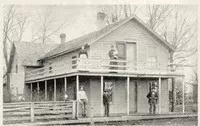
Mr. and Mrs. William H. H. Kennedy came to Independence township from Pennsylvania in January 1869. They rode on the first passenger train to pull into Maple Plain. They got off the train and the train backed up all the way to St. Anthony as there was only one track. Their son, Walter Monroe was only eight months old. They then had two daughters, Lilly May and Margaret Myrtle and a son, Harold Lester. Mr. Kennedy owned one of the first stores in Maple Plain. This property joined the E. A. Conovers on the east. Mr. Kennedy was taken prisoner during the Civil War, and at first was in Libby prison and later Andersonville. William's wife was Mary Elizabeth Painter, a daughter of George and Elizabeth Girt Painter. Paintertown, near Mound and Painter's Creek was named for this family.
Walter married Grace Vanderwerker, daughter of Arthur and Margaret Mealey Vanderwerker. Walter and Margaret had two children, Myrtle May and Oscar Raymond. Myrtle married Ray DeCamp, son of Harry and Nellie Pittman DeCamp. Myrtle and Ray had eleven children, Lily [Annette] Swaggert, Richard [Mike], Mazie Husby, Avis Riley Hankins, Olive [Duck] Sterzinger, Fern, Bernice [Honey] Silver. Ward [Buzz], Roxy [Wink] Jerde, Helen Dressel and Barbara Victoa.. Many decendents still live in the area. Myrtle later married Howard Budd, son of William Marshall and Zua Obert Budd. Oscar married Gladys DeCamp, daughter of Edwin and Mary J. Batdorf DeCamp. Oscar and Gladys had a daughter Elaine.
Lilly married Charles Budd, son of William White and Emmeline Cunningham Budd. They had Aimee Florence, Clinton Charles, Mary Loella and Ethel Irene. Ethel Irene married William Schultz and had Harry, Deloris Cole, Richard, and Robert. Many decendents still live in the area. She later married Frederick Hoehage.
Harold married Minnie Personett and had two daughters.
Organized in 1961 under the name Magna-Tek, Inc., the firm changed its corporate name in 1966 to Moulded Products, Inc. In the past seven years this company has grown to the point where it is now one of the largest firms in the plastic industry using the new and fast growing rotational molding process. It is today one of the largest manufacturers of hobby horses and is rapidly gaining national identity for its excellent indoor and outdoor playground equipment and other large size toys, including juvenile furniture. In 1966 this company moved into a new building and ten acres adjacent to the new building have been purchased for future expansion. Moulded Products, Inc. provides employment for many and is headed by Richard A. Barr, who has served as Vice-President and President since 1961.
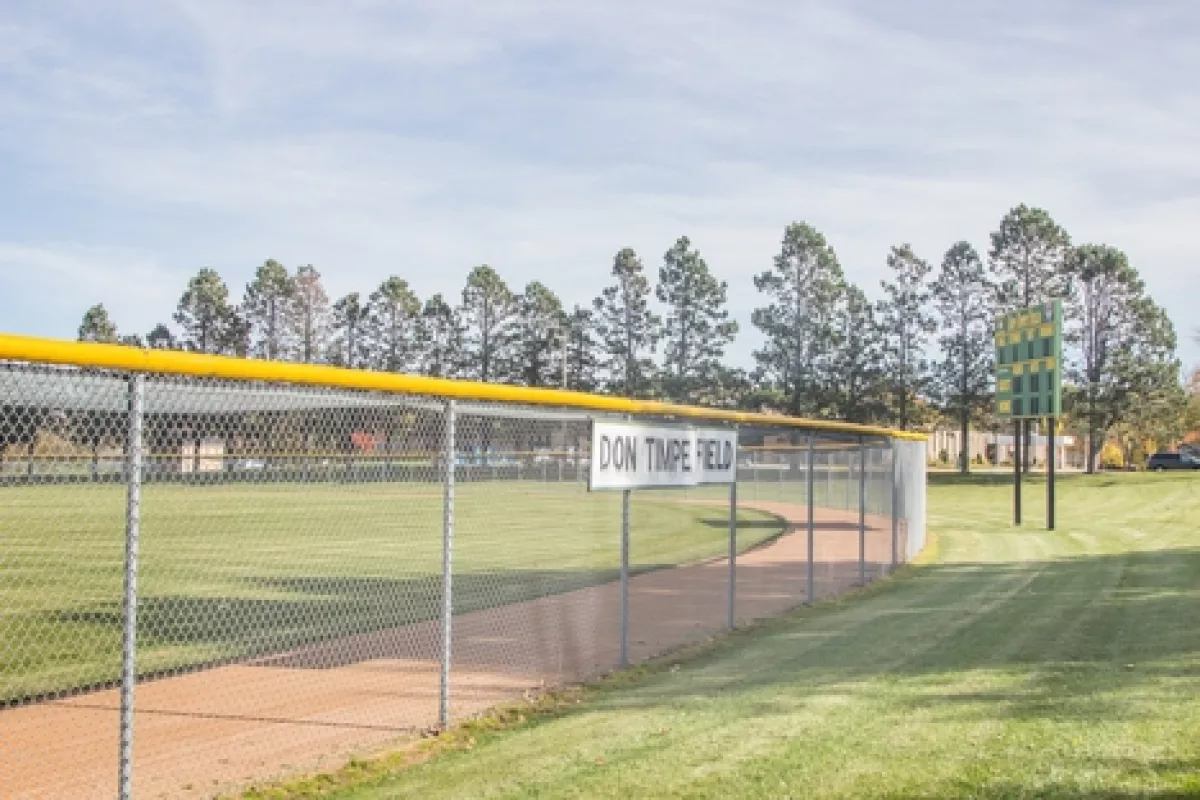
The Maple Plain Diamond Devils represent Maple Plain in the North Star League. The North Star League is a 13-team men’s amateur baseball league in the Minnesota Baseball Association with teams from nearby cities. League games are during the summer. Home games are at Don Timpe Field which is located in Veterans Memorial Park.
For more information and the team’s schedule visit Maple Plain Diamond Devils Website.
In 1944, the local congregation of the Maple Plain Seventh Day Adventist Church opened a parochial school with Miss Lillie Beeson as teacher and nine children from the local families as pupils. This school has operated every year since. A new addition has been completed for elementary use.
In 1897, Northwestern Bell Telephone Company acquired right of way across the Anna Mason land coming into Maple Plain and located its first phone at Conover's store.
On May 11th, 1904, Watertown Telephone Company was established, thus bringing service to rural Maple Plain in 1905. Service for the whole town of Maple Plain came in 1911 with 103 customers and hasgrown to 1333 in 1968. Telephone operators were paid $12.00 to $25.00 per month. Telephone poles cost 65c to 85c each in comparison to $18 to $25 now in 1968. The telephone office for Maple Plain was first in the J. C. Johnson grocery store at Lyndale, then to the Charles Cox. Hotel, later to the Maple Plain State Bank and finally in August, 1910 to the present site south of the tracks on County Road 19. In 1954 Maple Plain received its first dial system. The present building with more modern automatic equipment was built in 1964 and 2 years later conversion to extended area service to the Metro area was made available.
The old Armstrong depot which was a station before Maple Plain was, had been moved to Maple Plain's Main Street and became the house Mott Vanderwarker and his mother lived in for years. When the village bought the land and built the village hall, the old Vanderwarker house was unoccupied and deteriorating. The Maple Plain Garden Club enlisted the help of several of the businessmen and had the house razed and the land filled and graded. They seeded grass, bought and planted shrubbery, had a table and benches built, and are planting flowers in season and maintaining it as a village park which all are welcome to enjoy.
John H. McGary was born in Kentucky in 1842. In 1855 they came to Minnesota and located in Independence. In 1864 he enlisted in the Civil War and served one year. In 1866 he was married to Eliza Brandon. Their three children were Ruth, Katy and Omar Ray. John held the offices of assessor and town treasurer for nine years. He lived on the preemption claim made by his father on Section 15 for over sixty years. John McGary served during the Civil War along with S. Churchill, A. K. Richards, George Walsey, Robert Stimpson, James Shaver and others.
He wrote many articles regarding early events for a column for the Minnetonka Record. He wrote, "In 1857 the hard times and scourge of grasshoppers reduced the settlers to near poverty. The ginseng crop was called a God send to the people of western Hennepin County as the ginseng buyers paid spot cash, badly needed to pay taxes and buy necessities."
He writes of their journey to Minnesota, "In May, 1885, the families of Irvin Shrewsbury, John Williams, J. R. McGary and R. D. McGary and E. Brandon left southern Indiana by the overland route by ox team. It was seven hundred miles to Minneapolis, passing by Minnehaha Falls. On July 4th, 1885, we started out to settle in the Big Woods. There were no roads only a trail through swamp land and forest. On July 5th, we reached the town of Independence where Job Moffitt had made the first settlement, locating on Pioneer Creek in Section 22. My father took up his claim in Section 15, N.W. 1/4."
John's brother was Doctor Emus McGary from Missouri who was the father of Claude McGary who with his wife, Emma Cleveland, lived at Lake Independence.
Mr. and Mrs. Moses Brandon and sons, J.D. and Ebenezer, preempted land in Independence about 1856, coming from Jefferson County, Indiana. Their near neighbor, also from Indiana, was Frank Shrewsbury, who located here in 1855. J.D. Brandon, a farmer, also dealt in lumber and railroad ties. In 1876, he married Belle McDonald. Their children were Ida and Charles. Ebenezer Brandon was one of the first supervisors when the township was organized in 1958 at the home of J. Wilson. Overseer of the poor was Moses Brandon.
In the memoirs of Amanda Johnson, she records that she remembers her father saying that the snow came on November 20, in the winter of 1855 and 1856, and stayed on until April. The temperature was often thirty to forty degrees below zero.
Among the settlers who came in 1855 was William Lewis and his family. He died a month after his arrival here and was the first person to be buried in the Lewis Cemetery which was located on his claim and named for him. Other settlers in 1855 were Robert Stinson from Maine, J.W. and Needham Perkins from North Carolina, B. Barnhart, Thomas Thornton, and Frank Sutton, who later moved to Wright County. John Cathcart settled on Section 6.
Arriving in 1856 were Elkanah Cox, uncle of Charles Cox, who passed away in Maple Plain at the age of 91, having lived his whole life here; also Daniel Styner and family on what is now the Herum farm, Mose Williams and family, Henry Swingler, Wesley and Hollis Hall, John Stevens, Cyrus Chapman, Henry Astrope, Jacob Bryant, father of Rufus Bryant, Major Whitehead, William Kissinger, Ebenezer Sutherland, the grandfather of William Sutherland, William Fogleman. Sam Moody settled where Clifford Hillstrom farmed until recently. John Wolcott settled in the northwest corner of the township.
In 1857, the following settlers came: Jacob Rader, two sons, George and Washington, and a nephew, John Rader. Allen Hosmer built a sawmill on Pioneer Creek, but it was discontinued because of lack of water power. George Hoisington, from Wooster, Ohio, settled on what is now known as the Sunny Valley Farm, where the Gustafsons reside. Elkanah Shaw and Timothy Shaw located at Shaws Crossing together with John Wilson and Joseph Crooker of Maine, who owned a store in Perkinsville, Jacob Batdorf, grandfather of Mrs. Wallace Stinson, Mrs. Charles Soley, Norman Batdorf, and Henry Batdorf, all deceased. William Cox, who made a claim in Section 22, came from Indiana in 1856 to settle on Pioneer Creek. He had migrated from North Carolina ahead of the railroads and had never seen a train until the present railroad was built through his land, although he was sixty years old. Two years later he moved to Iowa where he died. S.W. Yokley came in 1864. Yokley and Breed opened a store in Maple Plain. The Yokleys lived on Lake Independence, on what has since been called the Doctor Peterson farm.
Andrew Nelson with his stone-grinding wheel and the good flour and meal he turned out. The big Fourth of July and Decoration Day celebrations with crowds at the picnic grounds south of the creamery in Mack's woods. — The special trains to bring prospects up for the sale of lots on Turner's Hill, with a band to liven thing's up, and other inducements to spur the sale of property. The same sort of promotion later when Independence Beach was platted. — George Molton, the station agent, knit and sold beautiful caps for most of the women in town in his spare time. — Crowds gathering to see passengers arrive on the train with Alfred Sandeen there to meet them with a high-wheeled bus drawn by a fine team of horses, and watch them depart for the Maple Hill summer resort on Lake Independence. — Oscar Fetterley ran a movie in a tent across from where Sig Anderson's electric shop is now. The generator was run by a gasoline engine with a wooden pulley which came loose one evening and ran down the street.
They were singing "Meet Me in St. Louis, Louis; Meet Me at the Fair", and beef steak was selling at nine cents a pound when two young brothers, J.R. and H.V. Miller snapped on black sateen half sleeves, put on long white aprons and opened their general store in Maple Plain on October 17, 1905. They had purchased 2 acres of land, which at that time was a corn field and located on what is now Main St. and Budd St. In 1904 a building 22 feet by 50 feet with living quarters on the second floor was constructed. The H.V. Millers lived there until 1934, when a new home was built on the property north of the store across the highway.
Merchandising is a "Miller" heritage. John Miller was a farmer in Cannon Falls. He also had a jewelry store, later a line of bicycles and gradually added other items with the help of his two sons H.V. and J.R.
Miller customers, who tied horses to the hitching posts and pushed their way past the cracker barrel and bolts of calico, could also breathe the fragrance of freshly ground coffee mixed with the stronger odor of kerosene. Wood burning parlor stoves heated the store, gasoline burning mantle lamps hung from the ceiling and also suggestive of the decorative ideas was the tin ceiling with a fleur de lis design. Store hours were from 6 A.M. to 7 P.M. The early opening was to accommodate the farmers who brought their milk and cream to Halgren's Creamery. Since 1905 the store-keeping business has been greatly revolutionized. The 100 pound sacks of flour and bolts of cottons have disappeared. Business at the old stand has undergone drastic changes as it has grown. In 1915 a 24 foot addition was added, doubling the floor space. This gave room for a complete assortment of dry goods, shoes and clothing. Additions were also constructed in 1950 and 1962. The present building, 110 foot by 60 foot, now includes complete meat and produce departments.
The store presently called "Millers Department Store" has always been a family-owned business run by J.R. and H.V. Miller and now by Everett V. Miller. Everett, son of H. V. Miller, bought out his father's interest in 1953.
Through the years "Millers" way of saying "thank you" to then customers and friends is a free smorgasbord served once a year.
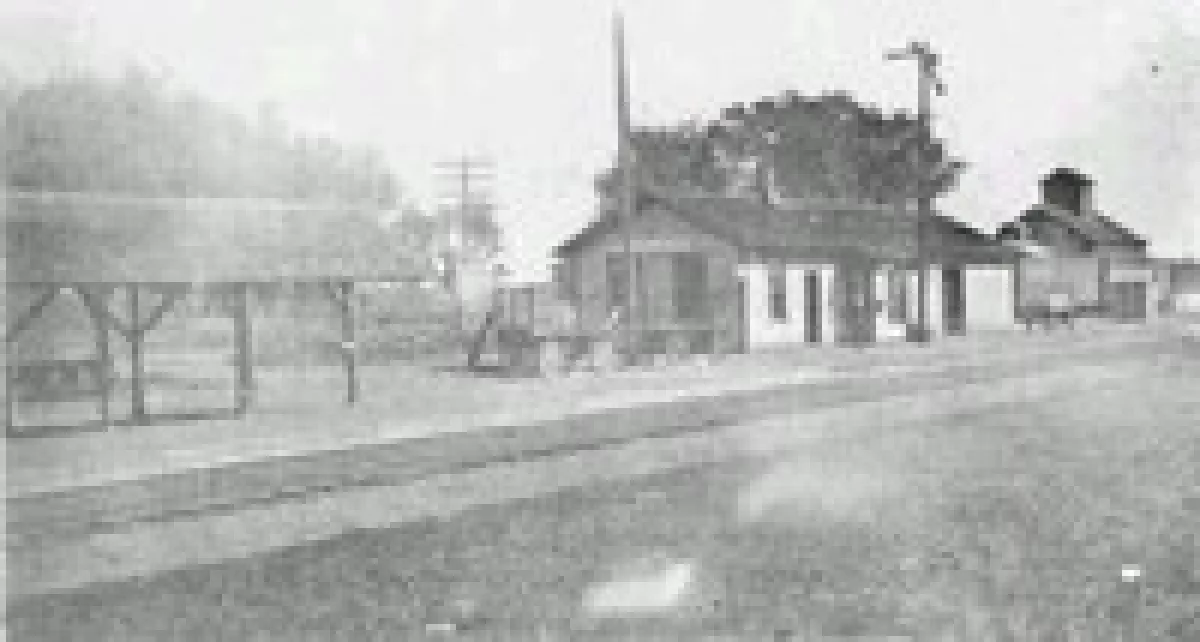
The Minnetonka Fruit Growers Association was one of the earliest co-ops in this area. It was organized in 1890. Long Lake was headquarters at first, and apples as well as berries were sold. Then as the market grew, both Long Lake and Maple Plain were shipping points. Later the office was moved to Maple Plain and fruit was shipped from this point only. The Great Northern depot in Maple Plain had a large roofed platform where farmers brought in and stacked the 24-quart strawberry crates, followed in a few weeks by the 24-pint raspberry crates, and the season tapered off with blackberries, currants and gooseberries. The west bound trains, the No. 21 at 6:00 p.m. and the No. 9 at 8:40, came in and loaded fruit ordered for towns in the Red River Valley, western Minnesota, and Iowa. Warm and uncomfortable people in the red plush seats of the passenger cars waited while the berries were loaded. The fruit being more perishable than the people.
The larger growers hired as many as one hundred berry pickers a day, pickers at times being paid one cent per quart for their work. Whole families from Minneapolis would come out for the berry season, living in tents or in the farmers' barns or sheds, and pick berries; glad of a chance to be out in the country. Berry picking was also the ordinary way for local youngsters, women and some men to earn money.
The berry business began diminishing after the first World War. Labor shortage, shrinking markets because of better transportation, and plant diseases all contributed. Varieties of berries grown changed; the Bederwood variety, named after the community later called Stubbs Bay was succeeded by the redder colored Senator Dunlap. Premier and Beaver varieties followed. Berries were picked every day but Saturday, there being no Sunday market. Farmers hauled the filled crates into town with team and wagons; later with cars and trucks, and loaded them onto the train platforms. As many as three thousand crates a day for a week were shipped out. Peak value was $75,000 for the season.
The business shrank until hiring a manager was no longer practical. The co-op directors finally sold their building (now Hankinson's Antique Shop) and office equipment and supplies. The funds were held in the bank for some years. A fair distribution of the money to former members seemed impossible, so the directors finally voted to give the money to the Orono School District for scholarships.
Niels Andersen, born Feb. 9, 1887, came to New Yorkon the vessel New York from Wenne Bjerg, Denmark on Jan. 2, 1914. He came with the encouragement from his Uncle J. L. Andersen, who was his sponsor from America, and settled in Wolbach, Nebraska. A friend of his uncle's needed a blacksmith in his shop so Niels came. His wife, Nielsine, followed with their two sons, Carlo and Helmer, on April 14, 1914. They also had a daughter, Norma (Mrs. Harold Starky), and a son, Egon, of Wayzata, born while living in Wolbach.
In Dec. of 1925, Niels and his family moved to Maple Plain. He then became the village blacksmith locating in the blacksmith shop formerly owned by a Mr. Peterson, where the Zwieg lawn and snow equipment store is now, then later moved across the highway.
In 1935, he moved into the old Mason place,, which was a part of a farm that was homesteaded on June 16, 1856 by William Fogleman. In 1871, a strip of land 150 ft. wide, was sold across the 80 acres for $100 for the railroad. In 1897, the Masons were paid $30.00 by Northwest Telephone Exchange to acquire right of way across the land. Highway easement was filed on March 9, 1922 for $1200.00. Anna Mason had a private cemetery on the land, near the house, where her husband had been buried. After her death in April, 1926 she also was buried there. Later the bodies were removed. Mr. 0. W. Olson, the new owner, rented this house and some land to Niels Anderson for 13 years before Niels bought it in 1948, where he lived until his death on May 18, 1963. His wife preceded him in death in August, 1958.
Niels and son Helmer remained in the blacksmith shop until about 1959. In 1937, Niels and son-in-law, Harold Starkey bought two school buses and started transporting high school pupils to Mound. Orono district was formed so more buses were bought and they transported children for Orono district only. A family corporation was formed, involving Helmer and son Randy. The newly remodeled bus garage is located directly west of the old railroad bridge housing three new buses.
In 1963, a medical building, owned by Doctor Leland Christenson, was built on Highway 12. Doctor Ralph Bergstrom Jr. came in 1967 as his associate.
Custom Service Company's business of helping other companies develop and service their special premium, contest, sales promotion, and merchandising programs began in Maple Plain in 1965. Custom Service runs its business in a new building which was added onto in 1968.
This Company employs approximately 100 men and women. The nature of this business has made Custom Service of Maple Plain known throughout the United States.
The Lock-Matic Tool Company, manufacturers of tools, dies, and small hand tools has been in Maple Plain 3 years in their present location in the old Moulded Products building since March, 1968. The owner is Walter Sarvie and his son Richard works with him.
Nyc and Ezy a food market containing a Rexall drug-store was built in 1966, on Highway 12 just west of the Maple Plain Bank. The store is open seven days a week and is owned and managed by Joe Reycraft, who is also the pharmacist of the drug department.
Maple Plain's first nursing home called the Maples was opened in November 1966. It can take care of sixty-seven patients. Clyde Wyman was the administrator in 1968.
In 1968 Dr. Alex Kowalenko, a dentist, had his office in a large building on Main Street which was built in 1966. There were two other offices occupied by the Lyon-Maski Insurance Company and Helmberger Lumber Company and also Ted's Pharmacy. On the second floor were six modern apartments.
The first apartment building, built by Everrett and David McKown in 1967 has twelve apartments. The second building built behind the first in 1968, has eleven apartments.
One of the new businesses in 1968 is a photographic studio called Reflections, operated by William Hedrick. The studio specializes in informal portraits taken in the home and in decorative pictures of many types, mainly in black and white. This business is located in the Schultz building where the post office was formerly located.
The railroad crew of Italian hand laborers who came to work on the first railroad cut in 1904 were housed in three big barracks west of the Armstrong railroad crossing. They dug a pit in a clay bank along the railroad track and would build a hot fire in it, then rake the hot coals out and put in big round loaves of bread to bake in the improvised oven. They bought chickens, milk and other produce from nearby farmers. They had an interpreter named Frank to make their wants known. Frank and Sam Macri, a well educated belligerent member of the crew parted company, and Sam went to live upstairs in Orlando Styner's granary. He had money hidden away and bought land from Clausen Briley, and lived in the little hat shop Annie Briley had operated on the Briley place. His wife in Italy died and his two children, Antonia and Joe, about ten and twelve, were living with an uncle there. Sam went back to Italy and brought his two children to his farm in Armstrong, built a big house, and lived there until his death. He raised lots of grapes to make his own wine for himself and his friends.
The first wooden bridge over the railroad tracks was built straight north and south joining Spring Street by Conover's store. The second bridge, slightly to the west was laid out with the north approach on the diagonal from Main St. The new bridge, scheduled to be built in 1969, will' be an extension of the creamery road going straight north to state highway twelve. Edward (Doc) Danielson's house will be a casualty.
0.E. Styner used to cut and haul cordwood to be sold to the St. Paul & Pacific railroad at the Armstrong depot. It was fuel for the wood burning train engines of that time. Roy Styner, his son, sleeps in the same bedroom he was born in seventy-five years ago.
Robert Mills from Henry Co., Indiana, volunteered and served in the Civil War from 1863 to 1865. Then he came to Minnesota and bought land from Job Moffatt who had proved the first claim in Independence township. This was north of Pioneer Creek, and adjoined the Styner place. He claimed each generation of that Scotch family had to have a Robert and a William which explains all the William Mills'. He used to say that Minnesota was such a healthy place to live, they had to kill a man to start a cemetery.
William Mills, father of Leslie Mills and Mrs. Ray Anderson, used to tell of being sent for the cows back in the marshy land west of the Armstrong cemetery. Wolves were howling, and both boy and cows were nervous. He held onto a cow's tail and both cows and boy hit the high spots running for home which was where M.C. Ostvig now lives.
The big old Benjamin Drake house on Spring Street was lived in by the Jacob Heinzen family who had twelve children. Later it was cut up into three houses, owned now by Mrs. Minnie Chenoweth, Karl Meyer, and John Ruff. The old Star Hotel was hand sawed in two to make two houses; Dick Ernst lived in one and Dick Schultz lives in the other. The old schoolhouse was bought at auction by Preston McCulley, who in turn sold it to Ed Pagenkopf and Murray Hill, who wrecked it and made two houses of it. The Pagenkopf house now belongs to Merle (Jim) Budd, on the old schoolhouse site, and Murray Hill used his lumber to build his present home. The fire escape (people got nervous about fire when George Mason's whiskers caught fire at a Christmas program) was divided up. Part of it is now the fire escape on the Presbyterian Church. Part of it wound up as an illegal fish trap in Pioneer Creek, and warden Art Gertz found it. Later it became a stairway and steps on the Merle Beer place.
Mae Mills Bergquist had a millinery shop in Offerman's house where Buelow's restaurant is now. Jennie Noreen, Mae Bergquist, Mamie Hill and Alma Peterson were apprentice seamstresses in the dressmaking shop above McCormick's store run by Mrs. Rachel Feming. McCormick's store became McCormick and Turnham before 1900. Then it became Turnham and Beer. Mrs. McCormick and Rachel Fleming both were sisters of Jim Turnham.
Henry Hardt operated a livery stable started in the 1890's where Ted's drugstore now stands. The Hardt hotel, same location, burned in 1938.
Durant's restaurant stood where the lumber yard is now located and the passenger trains used to stop for people to eat there. It was moved to become the Silverleaf Inn at the inter-section of county road 19 and Highway 12. Remodeled, it is now Andrew Swanson's home.
The early silent movies (a reel, a 3 minute intermission, another reel, and so on) (Ladies will please remove their hats flashed on the screen as long as a lady had a hat on) were held in the hall owned by Henry Pearson next to his home near the south side of the bridge. This location had been a farm implement and furniture store run by Ed DeCamp and 0. E. Styner, followed by Bill Peterson's blacksmith shop, and then Pearson's movie, entertainment and dance hall. It was bought and rebuilt by Ernest Pearson and Albert Thompson for their milk route trucks.
Albert bought Ernest out, and it was used for a garage to house the village fire trucks until the new fire barn was built. C. W. Christopherson now owns it.
The Odd Fellows, a popular lodge at that time, built a hall about 1890, and it burned to the ground in 1918. A new hall was built on the same site across the tracks from Conover's. Alvin Bryant hauled brick for the building with horse and buggy. It served as a social center as well as the lodge meeting place. Dances, box socials, home talent plays and entertainments were held there. Leslie Brown was one of the local dance band members who played there. The building was bought in 1945 by Axel Beck, Arnold Huss and Howard Johnson who were all cabinet makers. The company specialized in custom made store, restaurant, bank and bar fixtures. It changed hands in 1963 and is now operated by Einar Hagberg, joined in 1967 by his son Bruce, and is now Suburban Cabinet and Fixture Co.
At the Maple Hill Farm Resort, there were 25 cabins and the hotel. The cabins were not housekeeping, only for sleeping. The meals were served at the hotel. Cost: $8.00 per week, per person for room and board.
When Maple Plain had a town team playing baseball in the early 1920's, the players recalled are: The Ditty boys, Bill, Clayton and Perry, Claude (Hans) Budd, Art Amundson, Jim Budd, Mel Cox, Ernie Pearson, Ed Danielson, Ray DeCamp, "Bottle" Danielson, Mike Watry, Lawrence Setzler, Stan Hill and T. M. Ruud. Lars Pearson was bat boy. The ball field was on the cartway on the Bryant farm.
Asa Bennett operated a saw mill on the site of the Ed Danielson home. Ben Hoisington and O.E. Styner also operated saw mills. Dave Briley was the first blacksmith and H.C. Dickey the wagonmaker. Jim Turnham and George McCormick ran an elevator on the site of the Herbert Heinzen home before the railroad cut was made. Mr. Bennett also operated a broom handle factory across from the present Glen Hillstrom place.
The Olde Street Lamp Shop of Maple Plain moved here from Howard Lake, Minn. in 1955. It is owned and operated by Dick and Ethel Hankenson. The shop was formerly the warehouse of the Minnetonka Fruit Growers Association. Customers come from all over especially to buy furniture refinishing products which were developed and compounded by Dick Hankenson.
Mr. Hankenson's books on antique trivets (stands for flat irons and coffee pots) have been sold throughout the United States and Canada. A new book on trivets is now being printed, and will be ready this fall. The photography for this latest book was done by Mr. and Mrs. Walter Loggers, former residents of Maple Plain.
We have a record of the William and Sophie Pagenkopf family. They were born in Prussia, came to Illinois and then to Minnesota in June, 1858. There were four sons and one daughter, Mima, who died at the age of sixteen. The sons, John, George, William and Benjamin all owned adjoining farms in Independence. Mrs. Grace Hill is a daughter of George. His son, Edward, died in 1933. Edward's daughter, Gertrude Archer, lives at Pine River, Minnesota. William Pagenkopf served in the Civil War in Company I of the Second Minnesota Infantry. He contacted a disease in a southern prison camp and died in May, 1871. Mrs. George Pagenkopf and her sister, Mrs. Claude McGary, were killed in a horse and buggy train accident at the Loretto crossing in 1912. C. E. Marquart owns the farm where the Pagenkopfs settled.
In 1857, two brothers, who were Quakers, John S. and Needham Perkins, each built a frame house on the south shore of the lake. These were the first two frame houses in this area. They platted a portion of their land into a village known as Perkinsville. Part of it was in Medina township. Needham Perkins built a saw mill, a country store and a blacksmith shop. There was also a brick kiln. The clay contained too much limestone so brick making was discontinued. Bricks were found about the place which was later the home of Alfred Sandeen.
In 1859, Irvin Shrewsbury and John Perkins ran for the first state legislature. Shrewsbury, a Republican, was elected. Both men were active in the growth of Maple Plain. Perkins moved the store he had in Perkinsville to Maple Plain, but sold it in 1870 to G. W. Smith.
The Peter Soley family came in 1874 and settled on the Crooker farm on Pioneer Creek. His son, Charles, and his wife, the former Estella Batdorf, lived on the old farm until they built a home in Maple Plain in the 1940's. Charles worked in the Ben Drake general store and later managed the Lyndale Creamery for forty years. He served in the offices of town clerk and treasurer of Independence and as the treasurer of the cooperative elevator in Maple Plain. His children are Edward and Chalmer Soley, lone Japs and Irma Sutherland.
The settlers' wives and children stayed home to tend whatever animals or chickens they had and work the gardens planted in hastily prepared ground, scratching the soil with homemade tools, at first using seed they had brought with them. Their life was hard, but one woman wrote, "We are no poorer than our neighbors and no richer." The women, missing the flowers of their former home gardens, exclaimed with delight upon discovering the pink and white lady-slippers (moccasin flowers), the dainty violets and anemones. The settlers returning from St. Anthony likely stopped at Wayzata, formerly called Freeport, at one of the three crude hotels orhostels where a meal of home baked bread and baked coon or woodchuck stew could be enjoyed, while hearing news of other settlements.
Besides the hardships that accompany pioneer life, our early settlers lived with the fear of Indian uprisings. Serious trouble was experienced in other settlements. Long Lake had a great scare in 1858 when many Chippewa Indians passed through their town carrying scalps and trophies after a battle with the Sioux near Shakopee. In the winter of 1856-57 about three hundred of them camped on Pioneer Creek and the following winter about double that number. The settlers here were annoyed by stealing and begging, but no actual killings. It is reported that at times a friendly Indian left freshly killed meat or a brace of partridge on the doorstep of a destitute family, but these acts were not common.
Other hardships that caused some settlers to abandon their claims were the ravages of grasshoppers, drought and hail. Also, the financial depressions of 1850 and 1860 caused near starvation for not a few settlers. Some picked bushels of cranberries from the marshes and sold them for much needed cash. In cases of extreme need, money for seed for the next year's crop was appropriated by the legislature.
Their cabins were small and contained only the bare necessities. If there were children, they usually slept in the loft to which they ascended by a rough ladder nailed to the wall. It was not unusual in the winter to find patches of snow on their beds. Their toys were rag or cornhusk dolls or animals whittled from wood.
The women tried to make their homes a bit more attractive, papering walls with newspapers if available. One woman contrived white window curtains from her best muslin petticoats. Some had been able to bring a few prized possessions from their former homes, a clock, a trunk, a few books. The baby was rocked in a homemade wooden cradle. When time could be taken from the endless clearing of the land, some were able to build a "lean-to" onto their cabins for more space as the family increased in size. The beds often had rope springs and cornhusk mattresses, freshly filled when the corn had been picked.
The men worked long days clearing the land. Trees were felled, logs rolled, brush piled and burned. Soon a patch of land was ready for the plow, pulled by the oxen, and potatoes, wheat, barley or corn were planted. Hay was cut in the marshes for the cattle. The women and children helped pole the hay and stack it. The oxen furnished the power, hauling supplies in heavy cumbersome carts. They pulled the first grain to the mill. It is recorded that Vincent Cox and the Foglemans brought the first horses into the region.
Neighbors were often far apart but found ways to help and encourage each other. On special occasions small parties called "kitchen sweats" were held in the homes. John Hillstrom, who came from Sweden, was in great demand as he could play both the accordion and the violin. The party food was simple but joyously shared. Other events were logging bees and taffy pulling parties. The taffy was made with maple sugar.
The St. Paul, Pacific and Manitoba Railroad was built through Maple Plain in 1868 and 1869 and a railroad station was established. About this time the post office was moved from Armstrong in Independence to Maple Plain. The first postmaster, named Yokley, resigned to become the first depot agent and John Perkins became the second postmaster. The settlement of Armstrong consisted of a depot, a general store and several houses. Mr. George W. Smith became postmaster of Maple Plain in 1870 at which time one pigeonhole 3 by 4 inches furnished ample storage for all mail matter.
After the completion of the railroad there was market for cord wood. A railroad station was started at Armstrong to load the wood, which brought in cash to the settlers, as stoves were coming into common use. Some settlers, used to heating with fireplaces, had never seen a stove before. Cord wood was also sold to the railroad for the wood burning engines. Prior to the coming of the railroad, settlers would haul wood on sleds pulled by oxen to St. Anthony, selling it there and buying needed provisions, salt pork, corn meal, salt, sometimes cotton cloth and nails for building. If they could not afford nails they used wooden pegs. Some homes still standing are examples of this. The trip to St. Anthony took three days, a day travelling each way and a day to do their trading. St. Anthony Falls furnished water power for flour and lumber mills and was growing rapidly.
Robert M. Mills was born in New Castle, Indiana, August 7, 1845. He enlisted in the 9th Indiana Cavalry at age 18 and served until the close of the Civil War. He moved to Hennepin County in 1865 and married Maria Batdorf of Independence township in 1866. His farm was in Section 22, which was a claim formerly owned by Job Moffitt. Mr. Mills was town clerk of Independence for 23 years. Justice of the Peace, and postmaster at Maple Plain for 20 years. His son, Dexter moved to Saskatchewan, Canada where he passed away, and daughter Mae, Mrs. Arthur Berquist, still resides in Maple Plain. His brother, William Mills, took a claim in 1857, east of that of Irvin Shrewsbury. He married Margaret Batdorf, sister of Maria Batdorf, who married his brother, Robert. Mr. and Mrs. William Mills celebrated their 60th wedding anniversary here on May 8th, 1917.
Fortunately, in times of crop failures or the grasshopper invasion, a native plant saved the day for many. Ginseng was found to be abundant in the area. Whole families hunted the woods for it, for which five or six cents a pound was paid by buyers in drying sheds at Wayzata and Excelsior and later at Rockford. The dried roots were shipped from St. Paul to China where they were highly prized for medicinal or ceremonial purposes and favored for seasoning foods.
Samuel Briley was born in Canada in 1835. In 1858 he was married to Jane Delahunt who was born in the Province of Quebec in 1841. They settled on their farm at Armstrong in 1876 where six children were born to them. One was Mrs. Frank Lucas of Little Fork, Minnesota and another was Mrs. B. R. Hoisington of Maple Plain. The home of the Brileys was near Armstrong station. Sam's brother, Landon and wife lived where the Fred Pagenkopfs now live. Claude Briley was Clauson's son, and grandson of Sam Briley.
Landon was married to Annie Briley who in later years lived in Anoka and passed away there in 1966 at the age of 101, leaving one daughter, Mrs. Gladys Wellman.
In 1870, School District No. 102 purchased from Thomas Astrope (Astrup) 1/4 acre of land for the sum of $10. A school house was built, but about twenty-two years later this building was moved off the property and the present building was erected. It has since been moved onto a foundation and a small addition put on the front. Also one and a half acres more land has been purchased.
J.H. McGary served as Clerk of the district for many years, and the school was known as the McGary School.
In 1930, the teacher, Mrs. S. Thomas, and the school children bought evergreen seedlings and planted them along the north border of the school yard. These trees grew rapidly, and the school became know as "The Evergreen Grove School". It is located on Hennepin County Road 11.
Because of its proximity to the Twin Cities, this school has been host to distinguished foreign visitors who wish to visit a one-room school.
In the fall of 1956, a group of over forty members of the French Parliament, including former Minister of Education under Menees France, visited the school. They could not speak English, but with the aid of their three interpreters carried on a conversation with the teacher, Mrs. Donald Willis, and the children.
The first school was held in one room of a vacant house on the Thomas Astrope farm and Mrs. Anna McKee taught at that time. When the first school house was built Rhonda Stewart was the teacher. Later Mrs. Stella Chance, wife of a Delano doctor, taught there.
In 1964 the school consolidated with the Delano district. The school building has now been made available for community gatherings, 4-H Clubs and special events.
John Robert Stinson secured title to land in Section35in Independence in 1857. He was born in Maine in 1842 and passed away in Maple Plain in 1905. In 1863 he was married to Frances Worthington of Illinois. She died in Maple Plain in 1918. He enlisted in the Civil War. He was the father of the late Wallace Stinson who married Dora Batdorf. He farmed west of Maple Plain. Louis Stinson who married Esther Cox Stinson, was the son of J. Wallace and Dora Stinson. Louis Stinson had two sons, Lawrence and Robert.
Paul Stinson, son of J. Wallace and Dora Stinson, was the first serviceman from this area to die during 'World War I. He passed away at Fort Snelling Hospital October 11, 1918, during the influenza epidemic. The American Legion Post at Maple Plain is named for him, the Paul Stinson Post, No. 514.
Orlando Styner and sons Glenn and Roy built and stocked their hardware store in 1913. Glenn died during the first World War, and Mr. Styner and son Roy ran it. They built the present main building in 1932. In 1937 the business passed to Roy; Arthur Swenson joined him in 1941, and then Roy's son Glenn joined the firm. When Glenn became the village postmaster he sold his interest; Roy had already sold to Swenson in 1959. Art's son Terry became his partner in 1964.
Charles J. Anderson and wife, grandparents of Sigfred Anderson and Mrs. Dorothy McCulley came from Red Wing in 1893 and settled in Maple Plain. Charles purchased land and a house where the present post office and Harold's cafe now stand. They lived on the corner and their son, Fred Anderson had the first barber shop in Maple Plain in a room in the same house. Business was not brisk and the shop was only open on weekends. Later Christine Pederson, now Mrs. Louis Larson of Hopkins had a dress shop in this home. Behind the house was a slaughter house, run part time. Later the family settled on Lake Independence on property now owned by a great grandson, Robert Don Anderson.
Mrs. Charles Anderson was a sister of Dr. Norilius, the founder of the Augusta Lutheran Church of America. One of these churches was at Vasa, Minnesota, where Pastor Ralph Belin, former pastor of Christ Lutheran Church now preaches and resides with his family.
In the late 1880's Alfred Anderson came from Red Wing and settled where the Gustafsons now live on the Sunny Valley farm. Later they moved to the farm now known as the Ingold farm, where they built a home mostly from lumber sawed from their own trees. One son Sigfred, still residing in Maple Plain built an elevator and coal yard. His first employee was Levi Carlson. The same elevator with a later addition is the present Farmers elevator. They built a home and lived for several years where Harold Heinzen now lives. Later Sigfred and family ran the Shady Beach resort on Lake Sarah for eleven years and still later went into the electrical business with his sons. In 1933 he built the building in Maple Plain now housing the Sigfred Anderson and Sons Electrical Company. This was the former site of the post office which was moved onto Amanda Johnson's property and became the Maple Plain Library. It is now used by the Boy Scouts and American Legion.
Gordon Cummings began operating his hatchery and poultry farm in 1952. It has been mainly a commercial operation, although they had a self-service egg business for the public.
The Hatchery has not been in operation for six years, but as many as 4,000 chicks were hatched here each year.
Approximately 50,000 dozen eggs were sold here each year. An interesting fact is that the Cummings Hatchery sold fertile eggs to the Ghostly Poultry Co. then these eggs were used in polio vaccine research which finally became a reality in the form of Salk Vaccine!
Notes from a record written in 1949 by Thelma Gabrielson
Settlement of this area began in the 1850's. Early settlers were William Kissinger whose claim was in Section 27. In 1860 Abel Coffin and his sons, Frank and George, Mrs. Merriam and Mrs. Robert Barts settled in Section 33 in the heart of what is now Lyndale. They were Quakers. Mr. Fletcher Ingerson came in 1865. He had two daughters, Miss Martha Ingerson and Mrs. Jasper Jadwin who resided many years in the original home. Mr. Ingerson came from Pennsylvania after serving in the Civil War.
In the 1870's and early 1880's the Swedish immigration to this district began. Peter Berg came in 1875 and John P. Gabrielson in 1881. Most of the following had also come from Sweden — P. W. Johnson, Peter Danielson, Nils Anderson, Aaron Peterson, C. Gustafson, Eric Johnson, Nils Hanson, Andrew Lindberg, J. C. Johnson, W. Blacketer, John Bergstrom and A. R. Chaffee. At about this time a Mr. Hoglund built onto his log cabin and opened the first general store. Once a week he would haul the mail from Maple Plain and so a post office was established, called Hog Boo, which in Swedish meant "a little town on the hill." In 1890 the name was changed to Lyndale. There was an Indian trail through the Gustafson farm and relics such as arrowheads, Indian pipes etc., were found, but most of the Indians seemed to have left following the treaty of 1851. Frank Coffin built a store which was later managed by Mr. Harlan Noreen. Mr. Walstien was the blacksmith. In 1894 a creamery was organized by John Roder, Frank Coffin and Fletcher Ingerson who was first president of the Lyndale Creamery. Three big separators were run by steam. Butter was made here and hauled into Minneapolis for sale. The area was principally known for general farming and dairying.
In the early 1880's the first school was held in a log house. The school term was four months during the summer. Later, the pupils attended schools called Armstrong, Lee or Cope-land, whichever was nearer their homes. In 1892, District No. 126 was formed and a school house was built costing $585. The first teacher was Maggie Ingerson who was paid $30 per month. Books were bought by the parents. School was not compulsory and the children attended as long as they or the parents wished.
In 1914 a railroad called the Luce Line was built from Minneapolis to Hutchinson. The station was built about a mile from Old Lyndale. The train carried freight and one passenger coach. Almost overnight the new settlement near the station of New Lyndale, grew up. There was a post office in the Carsten store, a bank, machine shop, lumber yard, hardware store, blacksmith shop, feed mill, tabernacle and garage were built. Gradually these have disappeared and today a store, tavern and garage remain, so Old Lyndale continues as the center of this farming community.
Occasionally, travelling preachers would be in this area and meetings would be held in the homes or the schoolhouse. Soon the people felt the need of a church of their faith. Through the efforts of Mrs. P. M. Johnson, who walked about three miles to the Gotalund Swedish Lutheran Church near Maple Plain to induce the pastor to come to Lyndale, services were then held in the school. On January 21, 1898, the Lyndale Swedish Evangelical Lutheran Church was organized at the John Gabrielson home. The total communicant members and their children was 97. Reverend P. E. Berg of Watertown was the first pastor with a salary of $75 a year. Services were held every other Sunday afternoon. The first deacons were John Gabrielson, Peter Hofstedt and Nils Hanson. The first trustees were Nils Anderson, Peter Danielson and A. Lindberg. Four hundred dollars was borrowed for the building fund and the labor was done by the men and boys of the congregation. In May 1899, the church was finished and dedicated. The Ladies Aid was organized in 1898, and the Luther League in 1909.
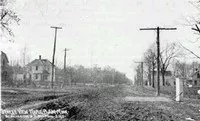
A box factory south of the creamery was owned by Mr. Ingersoll, where berry boxes and crates were made and sold to the farmers engaged in the thriving berry business which was organized as the Minnetonka Fruit Growers Association.
Charles Quass, a buyer of cattle, also had a meat market, later sold to John Shrewsbury and then to Robert Stumvall. The present laundromat is now in that building next to Buelow's restaurant.
The Odd Fellows Hall was south of the railroad tracks. Parties, plays, and dances were held there. It burned down, but was rebuilt. It is now owned by Suburban Fixtures. Roller skating was held in a hall next to Henry Pearson's mortuary, which was where Alvin and Gladys Dahl now live. His son Edgar built a new mortuary and later sold the business to Websters who moved to Mound, and sold out to Courteaus in 1961. Mr. Courteau enlarged the funeral home and the family lives in an apartment in the rear. In the early days this work was done by a lady mortician, Mrs. Edward DeCamp, who lived in town next to the railroad bridge.
A pool room and confectionery store was on the corner west of Miller's store. It was owned by Walter Kennedy and later sold to Alfred Hillstrom. The people who came for ice cream were served on the screened-in porch.
The lumber yard was purchased in 1903 from Mahlon Brothers. In 1906 it was incorporated as Lundsten Lumber Company with 0. W. Lundsten, President; and 0. J. Lundsten as General Manager, Secretary and Treasurer. The office was first located in what had previously been a meat market. A Mr. DeLong was the first manager, Louis Olson was manager for many years. During World War II the yard was closed for several years. It is the oldest business in Maple Plain under the same ownership. Present officers are C. N. Lundsten, President (whose father was 0. W. Lundsten), with the company since 1915, and his son James Lundsten, General Manager. Van Merriman has been the manager since 1947.
World War I veterans from this area:
Carl Anderson, Ernest Anderson, Clarence Batdorf, Eugene Batdorf, Clarence Beal, Aaron Bennett, Ole Bracken, Howard Budd, Percy Bradford, William Cox, Ray Collins, Bonnie Conover, Eugene Conover, Fred Conover, Edward Danielson, Henry Dressel, Clifford Ditty, John Frank, Raymond Hall, Murray Hill, Stanley Hill, Adolph Hallberg, Peter Elwell, Albin Johnson, Fred Kuntz, William Layman, Claude McGary, Harry Martinson, William Martinson, Arnold Nelson, Sidney Nolan, Frank Nolan, Joe Mason, Ernest Pearson, Ernest Peterson, Rudolph Peterson, John Rosch, Walter Schumann, John Shrewsbury, Lawrence Setzler, Paul Stinson, Glen Styner, Aaron Scheer, Carl Taylor, Howard White, Otto Scheer, Oscar Stotroen, and Otto Schilling.
Local men who died in World War I were:
Paul Stinson, Glen Styner, Ray Collins, Otto Scheer, Oscar Stotroen, Otto Schilling, Raymond Hall
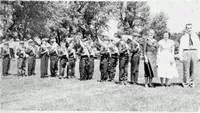
The following boys from the Maple Plain area served in World War II: Donald Anderson, Harvey Anderson, Howard Anderson, James Anderson, Egon Anderson, Merle Beer, Roger Bergquist, Donald Bryant, Loren Boehner, Kenneth Bruhn, Herbert Bodine, Robert Budd, William Budd, Earl Carlson, Richard Carlson, John Condon, Gordon Cunningham, Marvin Danielson, Ward DeCamp, Emerson Dressel, Wilbert Dressel, Donald Dressel, Keith Drysdale, Edward Erickson, Robert Ericson, Gerald Frank, Robert Hamilton, Julius Hardt, Raymond Heinzen, Richard Heinzen, Robert Heinzen, James Hendrickson, Ernest Henning, Herbert Henning, Arthur Herum, Curtis Hill, Louis Hitchings, Alvin Gertz, Melvin Gertz, Albert Japs, Fred Japs, Vincent Johnson, Robert Kauth, Raymond Kovert, William Layman, Jr., C. Paul Lindholm, Douglas McCulley, Harley Magnuson, Alex Miller, Everett Miller, Loring Mills, Harlan Noreen, Charles Oliver, Ronald Oliver, Duane Olson, Lloyd Osborne, Neil Palmer, Edgar Pearson, Donald Pearson, Gordon Pearson, Marcel Pearson, Lyie Pearson, Bernard Pearson, Norman Pederson, Earl Peterson, Howard Russ, Arthur Russek, Merle Smith, Harold Smith, Lawrence Stinson, Robert Stinson, Irvin Scheer, Wayne Stuckmayer, Glen Styner, Earl Taylor, Donald Timpe, Melvin West, Donald West, Morris West, Willard Wood, Milton Wooding
We regret that since World War II the records of the great number of boys who have been in the service is incomplete. Nevertheless, we wish to honor all who have answered the call of their country.

